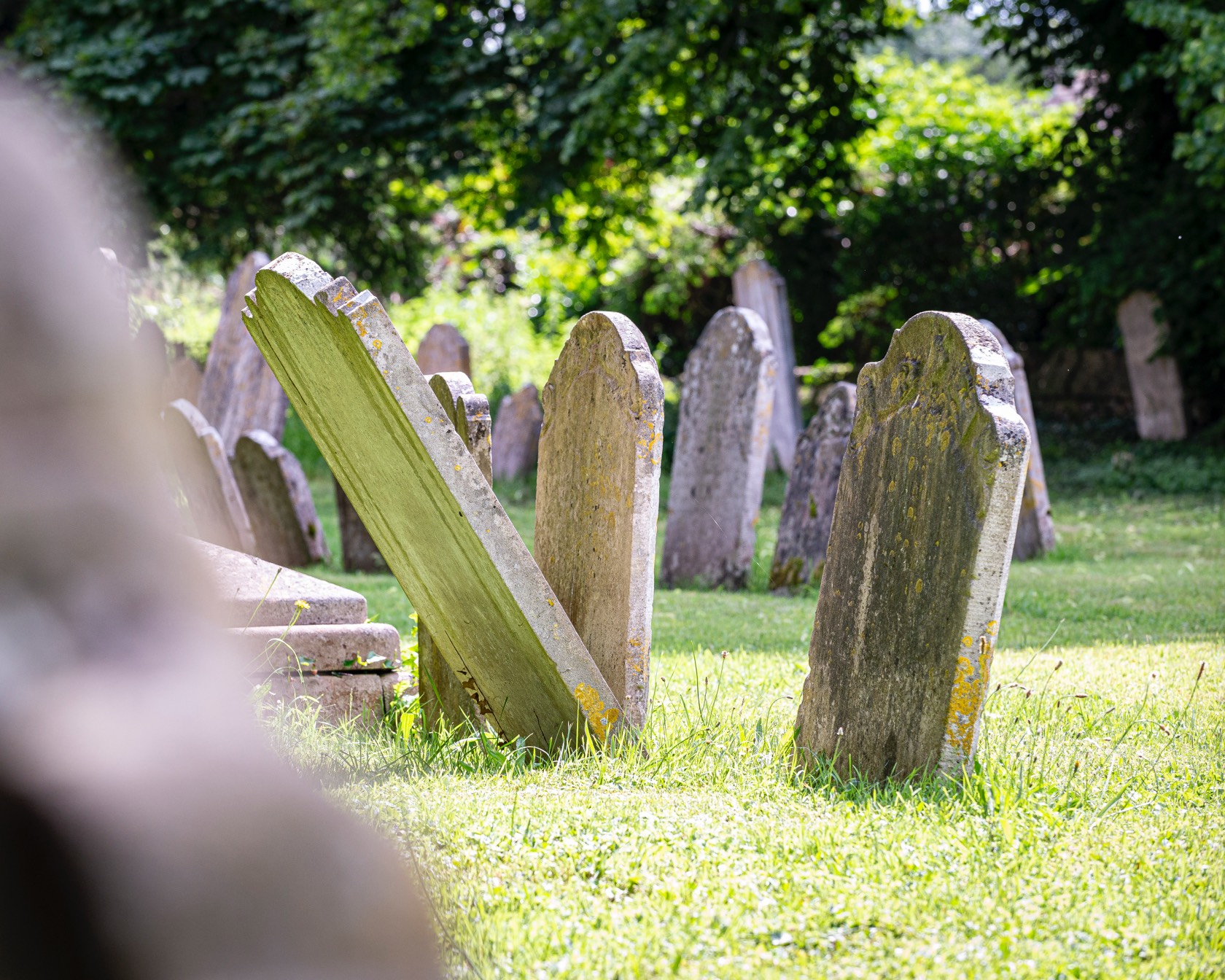The enclosure occupies an area of just under the traditional acre of the English mediaeval churchyard. It is roughly oblong in shape save that the southeastern comer is cut off by the curve of the road towards the Hampshire bridge. The church is sited oddly close to the eastern boundary, and the northern section is unusually large, doubtless because the main entrance is there (most mediaeval churches had their entrance on the south and there was strong prejudice against the darker and less frequented north, but this was overridden when the approach lay on that side). Sperling, followed by Mee, claimed that the churchyard only acquired this shape in the 16th or even 18th century: the yard would originally have extended eastward as far as the meadow across the present road, the road would have been moved from a former route west of the church, and the lost land made up by a new northern extension. The evidence has not been confirmed, and it seems unlikely that a new road would be driven through consecrated ground and part of that ground abandoned. An extension to the north may well have been made at some point, though not in the circumstances proposed by Sperling, and must have occurred before the yew avenue was planted.
The churchyard is bounded on the south side by the Lumley mill leat, taken off the Ems in 1760, and on the other sides by a stout wall of flint and rubble, topped by massive limestone coping-stones, many finished with a roll moulding along the ridge. Part at least of this wall must be over 200 years old for it appears in a drawing of 1782, and would have been built at a time when most parishes were content with a post and rail fence or quickset hedge. The most notable feature of Westbourne churchyard is the fine yew avenue of four pairs of trees flanking the north path. Local tradition has associated this planting with the work done on the church in the early 16th century, attributed to the patronage of the Earl of Arundel, and we are advised by a yew expert for the Conservation Foundation that the trees could possibly be 470 to 500 years old. Though not the oldest known in a British churchyard, the Westbourne avenue may be the oldest complete set (Bentley, Hants, is older at an estimated-600 years but has lost some of its original trees, as have the younger avenues at Cantref, Brecon, and St. Michael’s, Yeovil, early 18th century). Four later yews on the south side of the church and one flourishing specimen to the west were probably planted about 200 years ago.
Some areas of the churchyard have clearly been more popular for burial than others. Choice of a site was influenced by two considerations, both from early Christian tradition: first was the desire to lie near the church, especially the east end as the holiest part containing the altar; second, the wish to be near the main paths and entrance where passers-by would remember the dead. So the ground near the church has risen over centuries of burial, and the level is higher overall on the east side where the wall has been heightened and there is considerable difference between the levels inside and outside the churchyard.
The question of who was buried where is of some interest. Burial inside the church was an ideal beyond the sights of most people though becoming less restricted by the 16th and 17th centuries. Westbourne wills of the 16th century give a neat picture of the situation: fifty-four persons “bequeathed” their bodies to be buried in the churchyard (among them Simon Cotes the self-styled ermyt of Hermitage), and five to be buried inside the church, one “nye unto my seate” (there were already proprietary or customary seats), and one, the vicar Edward Johnes, stipulating burial in the quier or chancel. Interment in the church was always much more expensive than in the churchyard, and a frank opinion of the situation was expressed in the well-known epitaph of a sexton from Kingsbridge, Devon, in 1793, inserted at his own request:
Here lie I at the Chancel door
Here lie I because I’m poor
The forther in the more you’ll pay
Here lie I as warm as they.
Robert ‘Comonly Called Bony’ Phillip
In 1530 Richard Till of Aldmonington bequeathed 40s: “to make a Porche at the north dore of the church of Borne”. In the 18th· century when a gallery was built -in the north aisle, the east window of the aisle was transformed into a door and stone steps were constructed in the churchyard to give access to it; in 1821 it was decided to reverse the process with the construction of an interior staircase. At the same time the wardens found it necessary to clear away earth and construct a drain round the walls of the church “to prevent the Damps” caused by rising levels outside; this was an abiding problem, and the church floor has been raised at least twice in its history. The north-east section of the churchyard became the most popular, lying as it does between the chancel and the main approach, and here are the greatest concentration of monuments and many of the grander tombs.
Accounts of the period show odd small amounts spent on the churchyard, becoming more regular: 6d to a child for weeding paths, a couple of days’ work for a man, a cartload of gravel, repairs to the gate, and once a new plank for the Church Stile (probably on the south side where the small gate is now).
By the 19th century, overcrowding in city burial grounds and churches had become an acute problem, and when the Burial Act of 1852 empowered vestries to appoint burial boards and open new cemeteries, country parishes also began to consider closing their churchyards. At Westbourne the process was hastened, according to General John Oldfield’s son Richard (of Norman House), when his father had a family vault constructed in the churchyard in 1856; “thirteen skulls and endless bones were excavated”, and the shocked parishioners petitioned to have the yard closed. (The General had chosen a prime site by the north path in the most popular area, while parts of the churchyard on the south-west side were still little used). In 1858 it was decided to construct a cemetery off Foxbury Lane with a chapel and sexton’s cottage, and the churchyard was to be officially closed in 1859 though burials actually continued there for another year. The cemetery was consecrated by the Bishop of Chichester on May 31st 1860, and the first burial took place there on the following day. Burial inside the church, already fallen out of use, was formally prohibited, and interment in the churchyard was henceforth to be permitted only in existing family vaults and brick-built graves.
In 1863 the lychgate was constructed, at a cost of £29.17.1, and in 1865 the churchyard was levelled and sown, cost £15.0.0 (it had formerly been the custom to leave a turfed mound over the grave). In the same year the north porch was re-built – described by Sperling as “very beautiful” – and a new south porch was built as a memorial to General John Oldfield.
The churchyard is nowadays maintained by the Parish Council. Our parishioners assist with mowing of the grass and general gardening. An area on the west side is reserved as meadow land and supports several species of wild flowers, notably primroses. Daffodils have been planted along the west wall, and a few cyclamen coum east of the path.
Full details of all the churchyard memorials may be found here
The War Memorial stands at the North East corner of the churchyard beside the road. Details of the names recorded may be found on the ‘Roll of Honour‘ website.


